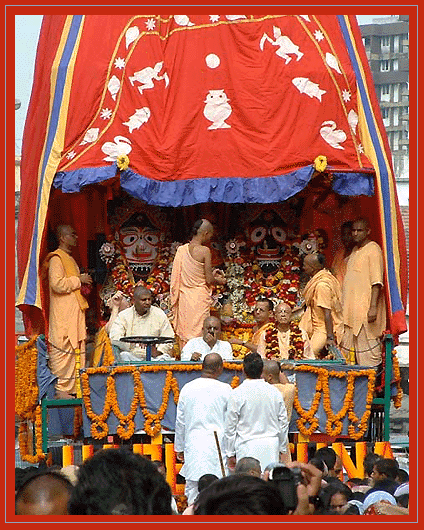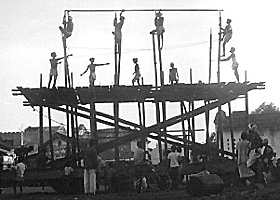

| |


Jagannatha Deities in a Ratha Cart
The records of Sri Jagannatha Temple in Puri reveal that after Maharaja Indradyumna had the deities installed in the temple, he requested Lord Brahma to prescribe the proper worship of Lord Jagannath (seva, puja and niti), which included twelve annual yatras, of which ratha yatra is the main one.
In Oriya, the language of Orissa, the word "yatra" means journey, or tour. Yatra might be performed on foot (pada yatra), by train, or by air (vimana yatra). Advanced devotees are also able to perform invisible yatra, traveling with the subtle body. For Lord Jagannatha's ratha yatra, the means of transport for Lord Jagannatha, Balarama and Subhardra is by way of chariot, or 'car'. This chariot vehicle is known as "ratha". Once each year, for a period of about 15 days, Lord Jagannatha travels out to spread his mercy. Those who have the good fortune to view the Jagannatha deities, or who help to pull the chariots along on their ropes, are benedicted by the Lord during the ratha yatra parade.
Ratha yatra is a celebration of the occasion when Sri Krsna (Lord Jagannatha) attended a religious function in Kuruksetra some 5,000 years ago, traveling from Dwarka in a big chariot along with Subhadra and Balarama. In remembrance of that event, the car festival takes place in Jagannath Puri every year, and millions of people go there to participate. Today, ratha yatra festivals are performed at temples around the world, and they are one of the paraphernalia of our Krsna Consciousness movement because they revive our consciousness about Krsna.
Srila Prabhupada said, "Therefore if you participate in these car festivals, as it is stated in the scriptures, rathe ca vamanam drstva punar janma na vidyate... If you kindly see these Jagannatha deities riding on these cars and in procession, and as Caitanya Mahaprabhu chanted the Hare Krsna mantra in front of this car, then according to our Vedic scripture, in your next life you'll go to back, back to home, back to Godhead."
Every year in Jagannatha Puri, Lord Caitanya took part in the car festival of Jagannatha, exhibiting symptoms of the mode of separation, as if Radharani was taking Krsna back to Vrndavana. So this Ratha-yatra festival is a feeling festival for the Vaisnavas. Lord Caitanya taught us how to feel separation of God. Lord Caitanya never taught us that He had seen God, but He felt the separation of God very severely.
The Ratha Yatra Chariots

Each year in Jagannath Puri, three enormous chariots are built anew for Lord Jagannatha, Balarama and Subhardra. Over 1,000 logs are brought from the Dasapalla and Ranpur forests, and more than 100 carpenters work for two months constructing the three chariots. A local mill provides nearly 2,000 meters of cloth each year, and the chariots are radiantly draped in color. Very strong coconut fiber ropes, 8 inches in diameter, are used by the devotees to pull the chariots along the parade route. The nails, brackets and fixtures are all made locally, and the smiths work for a month on them. The ratha's main structure (above the wheels) contains eighteen pillars and roofs. Each chariot holds nine parswadevatas (subsidiary deities), two dwarapalas (door keepers), one Sarathi (charioteer) and one presiding deity of the crest banner (dhwaja devata), and all are made of wood.
| |
JAGANNATH |
BALABHADRA |
SUBHADRA |
| Ratha |
NANDIGHOSA
GARUDADHWAJA KAPILDHWAJA |
TALADHWAJA |
DARPADALANA
PADMADHWAJA |
| Number
of wheels |
16 |
14 |
12 |
| Total
number of wooden pieces |
832 |
763 |
593 |
| Height |
13.5m. |
13.2m. |
12.9m. |
| Color of
cloth wrappings |
Red,
Yellow |
Red,
Blue |
Red,
Black |
| Guarded
by |
Garuda |
Vasudev |
Jayadurga |
| Names of
charioteers |
Daruka |
Matali |
Arjuna |
| The flag |
Trailokyamohini |
Unnani |
Nadambika |
| The
horses |
Shankha,
Balahaka, Shveta, Haridashva |
Tibara,
Ghora, Dirghashrama, Swarnanava |
Rochika,
Mochika, Jita, Aparajita |
| The
ropes |
Sankhachuda |
Basuki |
Swarnachuda |
| Presiding
nine Deities |
Varaha,
Govardhana, Krushna, Gopi - Krishna, Rama,
Narayana,Trivikram, Hanuman and Rudra |
Ganesha,
Kartikeya, Sarvamangala, Pralambari, Halayudha,
Mrutyunjaya, Natamvara, Mukteshwar, Sheshadev |
Chandi,
Chamunda, Ugratara, Vanadurga, Shulidurga,
Varahi, Shyama Kali, Mangala and Vimala |
Chart © 2001 srijagannath.com


|
|